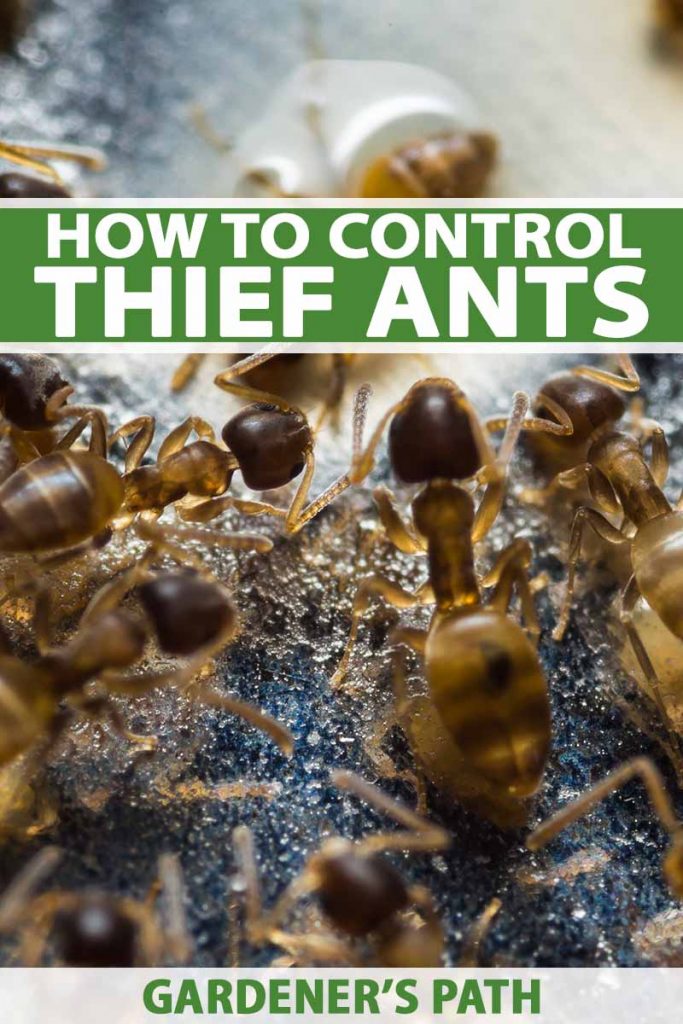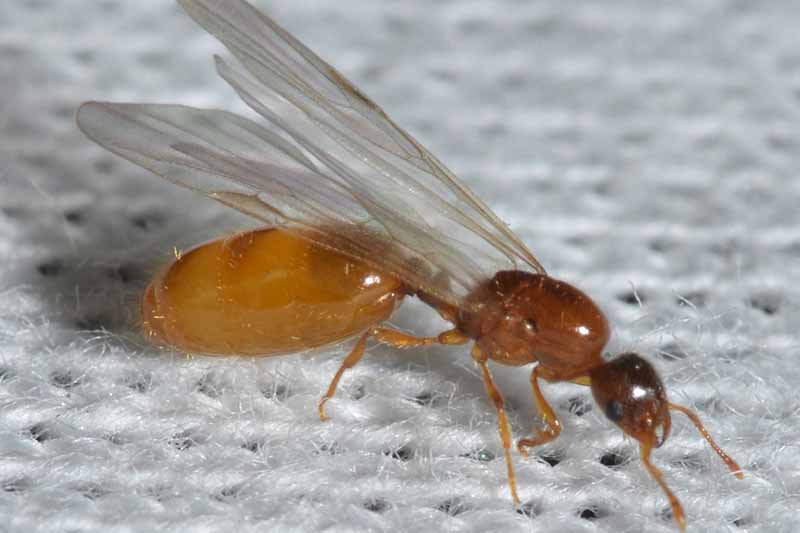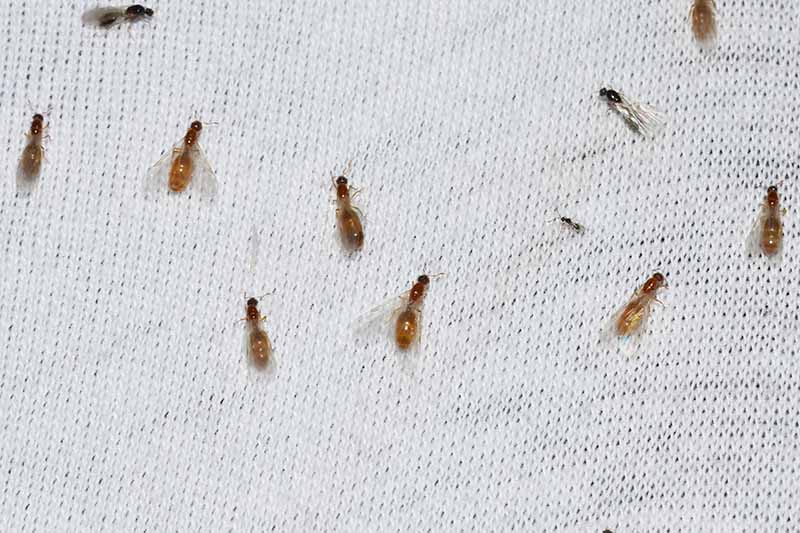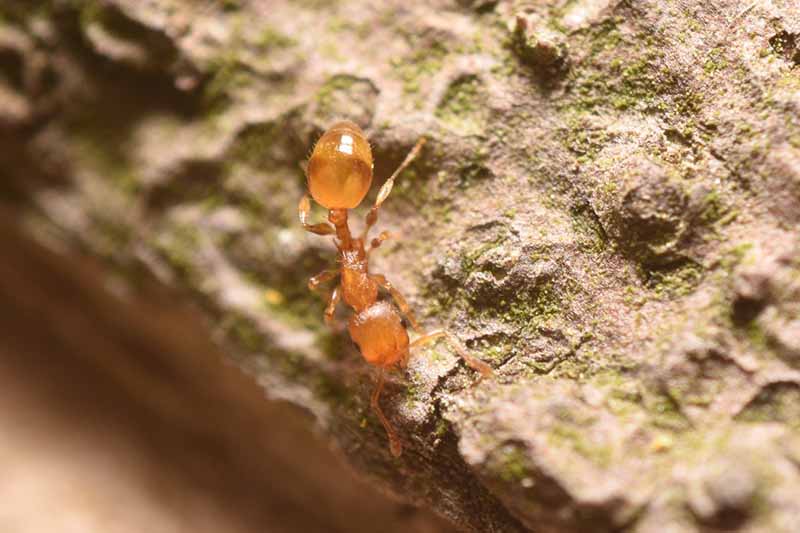This makes it convenient for them to steal food and larvae to feed the members of their own colony. These particular pests are one of the smallest species of ant around the world that commonly infest houses. Their tiny size makes them formidable opponents. It enables them to sneak into packaged foods, and hide almost undetectably in crevices in your home. We link to vendors to help you find relevant products. If you buy from one of our links, we may earn a commission. These insects can be difficult to control, but we will give you some tips on how to battle these tiny, persistent pests.
How to Distinguish Thief Ants from Pharaoh Ants
S. molesta are frequently confused with the dreaded pharaoh ants, Monomorium pharaonis, but telling them apart is relatively straightforward. Both insects are yellow to brown in color, but pharaoh ants are much larger. The features of their antennae are major distinguishing factors. Those of thief ants have 10 segments and end with an unusually large club that has two segments. In contrast, the antennae of M. pharaonis have 12 segments and end with a three-segmented club. The waists of S. molesta have two nodes, while the thorax lacks spines. If you are disinclined to inspect them too closely, the trails hold another clue. Thief ant trails are well-defined, while pharaohs only make trails once they have discovered food or water.
Colonies
Especially common on the East Coast of the US, thief ant colonies are unusually small. They are comprised of only several hundred to a few thousand workers (in contrast with Argentine ants that have colonies containing millions of insects), although they usually have multiple queens. A colony with multiple queens can continue to thrive long after one of the queens dies – normally a death knell to a colony that contains only one queen. These colonies are often located close to those of other ant species, so the little thieves can steal their food, larvae, and pupae. When these insects construct their nests, they can readily adapt to their surroundings. They are equally at home inside your baseboards, or outdoors in exposed soil, underneath stones and bricks, or inside decaying logs and tree stumps. In your home, these tiny pests will nest in cracks, crevices, and wall voids, behind baseboards, and under countertops. This can make them particularly difficult to find. The one thing common to these different habitats is that they are all close to food and water. S. molesta swarm any time from summer to early fall. They mate in flight, and a sole queen can start a new colony.
Food Sources
Thief ants don’t just steal the food and eat the larvae of other species. They will eat almost any kind of organic matter, ranging from dead rodents to honeydew and seeds. They are also partial to the food in your pantry, and are more likely to enter houses in search of food and water during hot weather. Once inside your home, they will eat pretty much anything – fatty and oily meats, cereals, sweets, dairy products, nuts, and vegetable oils. They will form trails from the food to their nest, taking their tasty treats back to the colony.
Prevention
There are a number of steps you can take to prevent an infestation of these tiny, thieving pests.
Move Potential Nest Sites
You don’t want these pests nesting by your house, so move anything they might use to nest in away from your foundation. This includes mulch, vegetation, firewood, and landscape timbers.
Limit Access to Moisture
Since they are attracted to moisture, you should fix leaky pipes and faucets, unclog gutters, and repair any downspouts that do not work properly.
Sanitation Is Key
Minimize access to food sources. Keep foods in sealed containers, and clean up any pet food each night. Make sure your countertops are clean, and don’t leave dirty dishes in the sink overnight. Keep your floors clean by sweeping and mopping, and take your garbage out regularly.
How to Control Indoor Infestations
Once you have determined that your infestation is indeed S. molesta and not a different species, there are a few things you can do to exterminate them. Members of this species are also known as “grease ants” due to their preferences for grease, while pharaohs, M. pharaonis, tend to prefer sweets.
Find the Trails
Your first step will be to locate the foraging trails, which will lead to the colony. This can be a bit difficult, since workers may only be visible some of the time. If you find that the insects are coming inside from outside of your house, seal the openings they use to enter your home.
Limit the Number of Foraging Workers
Experts advise against only treating an infestation by spraying your house with insecticides. This short term method will kill only the visible members of the colony and is likely to make control more difficult in the long run. The colony will continue to grow in size and will become more difficult to exterminate. However, limiting the numbers in your home by spraying or using boric acid dust, and vacuuming up the insects to remove them, will help keep the potential spread of disease at bay.
How to Control Outdoor Infestations
While bait stations are the usual go-to method to control those species that may have set up colonies in your yard, this approach does not work well with thief ants. If the infestation is inside your home, you can inject a dust or aerosol insecticide into your baseboards through cracks or crevices. Fortunately, less toxic insecticides like those used to eradicate fleas can be used to control them inside the house. Zoecon Precor 2000 Plus Premise Spray 16-Oz. Spray Can BorActin Insect Dust Insecticide with Boric Acid Boric acid has very low toxicity to humans and pets, but you’ll still need to exercise caution when using any chemicals in your home and garden, particularly if you have children.
Ant Baits
Once you have found the trail, you can place bait traps next to it. A grease or protein bait is best, given their preference for eating insects and animals. Raid Ant Baits III are available that contain the insecticide avermectin, at extremely low concentrations that are nontoxic to humans and pets. Raid Ant Baits III Bait Stations One advantage of limiting the food sources available in your house is that the insects will be much more likely to take the bait back to their colony – which can kill the queen and potentially eradicate the whole nest.
A potential complication here is that if the colony contains multiple queens and not all are killed, they will be able to start new nests and the problem will continue. Your best bet is to hunt down their nests and treat the infestations in your yard with compressed air sprays of a residual insecticide that is approved for use in your state. It may be difficult to locate the nest or nests. If this is the case, you can spray the perimeter of your house with insecticide to try to keep them from getting into your home.
Consider Professional Exterminators
Since thief ants can be so difficult to exterminate, you may want to consider bringing in a licensed pest control professional. He or she will be able to help you determine where the nests are in your yard, and they have access to more powerful baits and insecticides that may be applied.
While often difficult to distinguish from pharaoh ants, it is critical to do so because the control measures differ substantially depending on which species has taken up residence. This species can be extremely difficult to manage, but if you follow our tips you should be able to prevent and control infestations. Has your kitchen been overrun by thief ants? Let us know how you fared in the comments. And read on for more information on how to control ants in your home:
How to Control Odorous House Ants How to Control Citronella Ants How to Control Pavement Ants
© Ask the Experts, LLC. ALL RIGHTS RESERVED. See our TOS for more details. Originally published on January 20, 2020. [lastupdated]. Product photos via Raid, Rockwell Labs Ltd, and Wellmark International. Uncredited photos: Shutterstock. With additional writing and editing by Clare Groom and Allison Sidhu.








